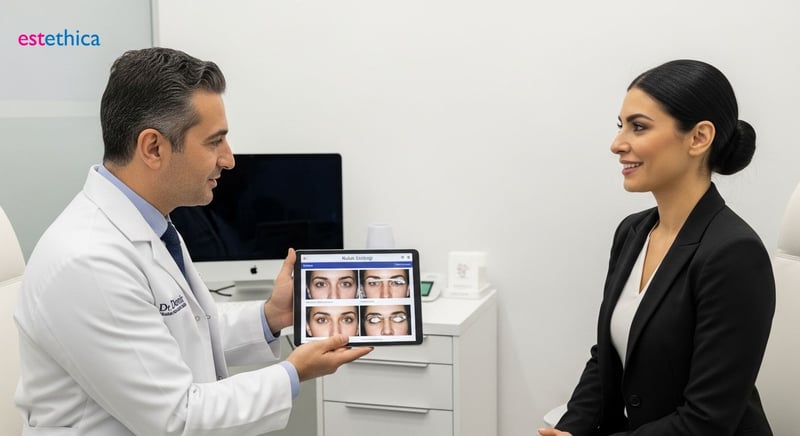Otoplasty Guide: Understanding Ear Surgery and Recovery
Comprehensive guide to otoplasty, covering ear surgery details, recovery expectations, and before/after results for prominent ear correction.
Understanding Otoplasty: What to Expect from Ear Surgery
What is Otoplasty?
Otoplasty, commonly known as ear surgery, is a cosmetic procedure designed to reshape or reposition protruding ears. It can also address deformities caused by injury or birth defects. The goal of this ear surgery is to create more naturally proportioned ears that harmonize with facial features. The procedure typically involves making incisions behind the ear to reshape the cartilage, which can then be pinned closer to the head. The techniques used vary depending on the specific issues being addressed, but the overarching aim is to achieve a balanced and aesthetically pleasing result. Patients often seek this procedure for self-consciousness related to their ear appearance, making prominent ear correction a significant confidence booster. For those interested in learning more about the general aspects of this procedure, consulting resources like Otoplasty: Your Guide to Ear Surgery and Reshaping can provide valuable insights.
The Surgical Process and Preparation
During the otoplasty procedure, a skilled surgeon will make small incisions, often hidden in the natural creases of the ear. Through these incisions, the cartilage is reshaped, bent back, or reduced to achieve the desired outcome. Stitches are then used to secure the new shape. The surgery is usually performed under local anesthesia with sedation or general anesthesia, depending on the patient's age and the complexity of the procedure. The duration of the ear surgery can range from one to three hours. Before undergoing the procedure, a thorough consultation is essential. This initial meeting is your opportunity to discuss your reasons for seeking cosmetic ear surgery and what you hope to achieve. The surgeon will examine your ears, discuss the surgical techniques best suited for your anatomy, and explain the expected outcomes. They will also go over the recovery process and answer any questions you may have. You'll receive instructions on how to prepare for the surgery, which may include stopping certain medications and arranging for someone to drive you home afterward. Understanding this preparation is a crucial part of the otoplasty before and after journey. The consultation sets the stage for successful otoplasty before and after results, ensuring you are well-informed and ready for the transformative experience.

Otoplasty Before and After: Visualizing Your Transformation
The impact of otoplasty on an individual's appearance can be truly transformative. For many people, ears that are perceived as too prominent or disproportionate can lead to feelings of self-consciousness, affecting their confidence in social settings and their overall self-esteem. Viewing otoplasty before and after photos offers a powerful, visual testament to the effectiveness of this procedure. These images frequently highlight a dramatic shift, where ears that once drew unwanted attention are now naturally positioned and aesthetically pleasing. This correction is a fundamental aspect of cosmetic ear surgery, providing a tangible solution for those seeking to improve the appearance of their ears and achieve a more balanced facial profile. It's a journey from feeling concerned about ear appearance to embracing a more confident reflection.
The Psychological Impact of Ear Appearance
Understanding the psychological benefits is as crucial as appreciating the visual results. Many individuals opt for otoplasty because their ears affect their self-perception. Prominent ears can lead to teasing, self-conscious behaviors like constantly covering them with hair, and a general reluctance to be photographed. The "otoplasty before and after" comparison powerfully illustrates how this procedure can alleviate these concerns. It's not about altering the fundamental structure of one's face, but rather about creating a sense of harmony and proportion. This can significantly boost self-confidence, allowing individuals to feel more at ease in social situations, participate more freely in activities, and develop a healthier self-image. For those considering surgical intervention, exploring these visual transformations can provide substantial reassurance and clarity about the potential positive outcomes.
Achieving Natural and Harmonious Results
While the visual changes from otoplasty can be striking, it's vital to approach the procedure with realistic expectations. The goal of this type of ear surgery is not to achieve an unnatural or exaggerated look, but rather to create results that appear natural and blend harmoniously with your facial features. Surgeons aim to refine the shape and position of the ears to address the specific concerns that led you to seek treatment, such as excessive protrusion or asymmetry. The satisfaction that comes from this enhancement is often profound, contributing to a renewed sense of self-assurance. To gain a deeper understanding of the techniques and possibilities, consider exploring resources like Unfolding Ears: Your Guide to Otoplasty & Ear Reshaping, which offers further insights into the process and potential outcomes of improving ear aesthetics.
The Otoplasty Recovery Process: A Step-by-Step Guide
Immediate Post-Operative Care and Comfort Management
The journey following your ear reshaping procedure begins the moment you leave the operating room. You can anticipate some swelling, mild discomfort, and tenderness around your ears. To ensure optimal healing and maintain the new shape, a protective surgical dressing or a specialized headband will be applied. This crucial bandage immobilizes the ears, minimizes movement, and safeguards the surgical sites. Your surgeon will provide detailed instructions covering wound care, effective pain management with prescribed medications, and essential activity restrictions. Understanding this initial phase is key to a successful outcome. Proper care in these first few days sets the stage for a smooth recovery.
Managing discomfort and swelling is a primary focus during this period. The careful application of cold compresses, as guided by your surgeon, can significantly reduce swelling and alleviate minor pain. Over-the-counter or prescription pain relievers are available to manage any lingering discomfort. It is highly recommended to sleep with your head elevated, using extra pillows, to reduce pressure on your ears and further minimize swelling. This simple yet effective measure is a cornerstone of post-operative care and contributes greatly to a comfortable healing period. Most patients find that the most significant discomfort subsides within the first 48 to 72 hours.
Returning to Daily Life and Long-Term Considerations
The duration of the recovery period varies depending on individual healing rates and the specifics of the procedure. Generally, many individuals can return to light work or school activities within one to two weeks. However, it is imperative to avoid strenuous physical activities, contact sports, and vigorous exercise for several weeks to allow the cartilage to heal completely and achieve its new position. Your surgeon will provide precise guidelines on when it is safe to gradually reintroduce these more demanding activities. Continuing to wear a supportive headband, particularly during sleep, is often advised for several weeks to protect your ears from accidental injury and maintain the surgical results. For a comprehensive understanding of what to expect, you can refer to Otoplasty: Your Guide to Ear Surgery for Perfect Proportions. Diligently following your surgeon's post-operative instructions is paramount for achieving the best possible results from your cosmetic ear surgery.

Prominent Ear Correction: Exploring Your Options with Otoplasty
Understanding Prominent Ears
Prominent ears, often referred to as protruding ears, are a common concern addressed by otoplasty. This condition occurs when the ears stick out further from the head than is considered typical, and can sometimes be accompanied by a large or unusually shaped ear. For many, especially children and adolescents, prominent ears can lead to teasing and social anxiety. Surgical intervention for this condition offers a solution to reposition the ears closer to the head, improving their overall appearance and reducing self-consciousness. It's a widely performed procedure that yields significant positive impacts on a patient's confidence.
Surgical Techniques for Correction
Otoplasty for prominent ear correction involves various surgical techniques, tailored to the individual's ear anatomy. Common methods include incisions made behind the ear to expose the cartilage, followed by reshaping it through scoring, thinning, or folding. Sutures are then used to hold the cartilage in its new position, effectively setting the ears back. The specific surgical approach will be discussed during your consultation, considering factors like the degree of protrusion and the ear's cartilage structure. The goal is always to achieve a natural-looking result that enhances facial balance. This type of ear surgery is designed to be minimally invasive with incisions carefully placed to be inconspicuous.
Who is a Good Candidate for Otoplasty?
Good candidates for prominent ear correction typically include individuals who are bothered by the appearance of their ears and are in good general health. For children, it's generally recommended to wait until they are around five or six years old, once their ear cartilage has developed significantly, but before they experience significant social distress. Adults considering this procedure should have realistic expectations about the outcomes of cosmetic ear surgery. Understanding the recovery timeline and being committed to following post-operative instructions are crucial for successful results in any prominent ear correction procedure. A thorough consultation will help determine if otoplasty is the right choice for you, addressing all aspects of the procedure and what to expect after otoplasty. The decision to undergo otoplasty is a personal one, and it's important to feel fully informed and comfortable with the process and potential results.

Otoplasty: Expert Ear Reshaping Techniques for Prominent Ear Correction
This comprehensive guide delves into otoplasty, commonly known as ear surgery, detailing expert techniques for reshaping or repositioning protruding ears. The surgical process, preparation, and specific methods for prominent ear correction are thoroughly explained.
We explore the advanced approaches used to achieve naturally proportioned ears that harmonize with facial features, ensuring aesthetically pleasing and balanced results through meticulous surgical execution.
Our content is crafted with in-depth knowledge of cosmetic ear surgery, focusing on the nuances of ear correction procedures. We emphasize the expertise required to address both aesthetic concerns and deformities, providing readers with reliable insights into the surgical process.
The detailed examination of otoplasty techniques showcases a deep understanding of ear anatomy and surgical precision, positioning this guide as a trusted resource for anyone considering ear reshaping.
Otoplasty Recovery Process: A Step-by-Step Guide to Post-Operative Care
The journey following your ear reshaping procedure begins the moment you leave the operating room, and this guide provides a step-by-step approach to the otoplasty recovery process. Managing discomfort and swelling is a primary focus during this period.
We offer detailed information on immediate post-operative care, returning to daily life, and long-term considerations, ensuring patients feel supported and informed throughout their recovery time.
Understanding the psychological benefits is as crucial as appreciating the visual results from otoplasty. This guide addresses both, providing a holistic view of the ear surgery experience and its positive effects.
While the visual changes from otoplasty can be striking, it's vital to approach the procedure with realistic expectations, which this guide carefully outlines to build trust and ensure patient satisfaction with their prominent ear correction.